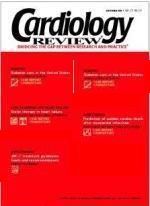Publication
Article
Cardiology Review® Online
Identifying diabetic cardiomyopathy Steven Borzak, MD
Diabetes has been recognized as an adverse chronic illness for years, but only recently has the magni-tude of its impact on outcomes in cardiovascular disease been fully appreciated. The recently published third iteration of the National Cholesterol Education Program has classified diabetes as a “coronary heart disease risk equivalent” because a patient with diabetes is at as high a risk of death or an adverse outcome as a patient who has had a myocardial infarction (MI).1 Furthermore, diabetic patients who have had an MI are at a much higher risk for death and complications than nondiabetic patients in subsequent months. These stark statements have placed diabetes on the cardiologist’s radar screen as a diagnosis of extreme importance. Its recognition and management cannot be ignored or relegated only to the primary care physician or the endocrinologist.
“Diabetic cardiomyopathy” has been a widely employed but variably defined term in the literature for years. Definitions have included the presence of microvascular disease, angina without significant epicardial stenosis, diffuse coronary atherosclerosis, and heart failure as a result of systolic dysfunction without definite transmural infarction. Many authors have debated the existence of a cardiomyopathy that is specific to diabetes; however, with increasing recognition of the heart failure syndrome in the absence of systolic dysfunction (so-called diastolic dysfunction),2 and with the development of Doppler echocardiographic criteria for characterizing relaxation abnormalities, the effect of diabetes on ventricular performance is becoming increasingly well recognized.
Fang and Marwick (page 26) have presented data demonstrating the effect of diabetes on sensitive and carefully described echocardiographic markers of early systolic and diastolic compliance. Their work is important not only because they replicate the finding that diabetes is associated with an increased prevalence of diastolic dysfunction,2 but also because they account for the often overlapping prevalence of left ventricular hypertrophy, a cause of abnormal diastolic function. They show that in the absence of left ventricular hypertrophy, diabetes is associated with an increased incidence of early systolic and diastolic abnormalities, and when left ventricular hypertrophy and diabetes coexist, the abnormalities are worse than with either entity alone.
Conclusion
The point of the article by Fang and Marwick is not necessarily to argue for the application of echo-cardiographic measurements of early systolic and diastolic function, but to suggest that diabetic cardiomyopathy can be described. Their article does not discuss treatment, but supports the argument for the aggressive reduction of blood pressure and low-density lipoprotein cholesterol in diabetic patients well before the clinical syndrome of heart failure develops.
